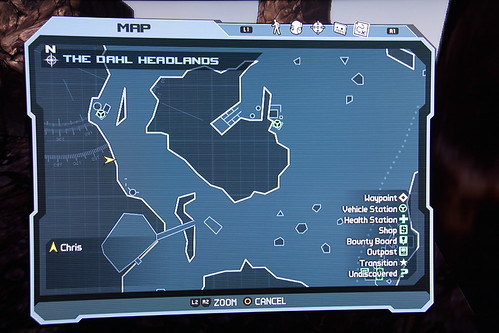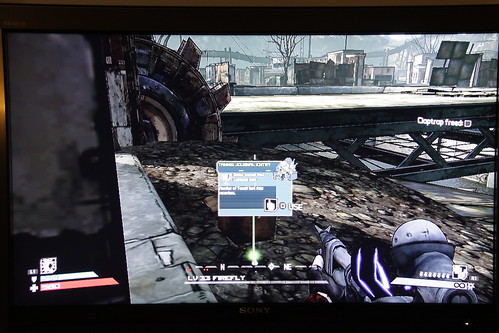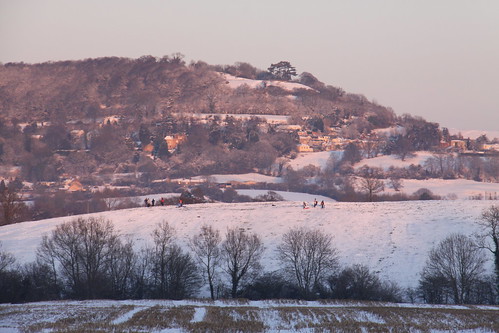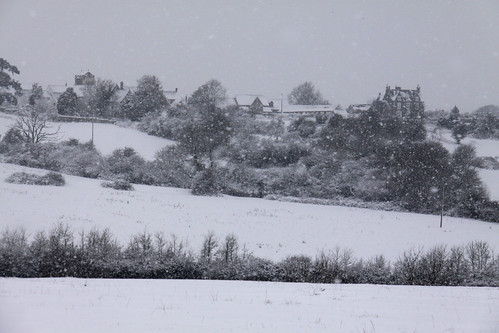New content! Raised level cap! Squeee!
October 2010 will bring the 100th anniversary of the date when Robert W Wood took the first infrared (IR) photograph, so there's a nice article on the BBC's website about IR photography today that's well worth a read. I'll be keeping tabs on Andy Finney's Infrared100 website, which gets a mention.
I've loved the look of IR photographs ever since I was old enough to appreciate what photography could do. A photograph shot using IR sensitive film lends even the most mundane subject a strange, other-worldly character that comes into its own when the photo was taken outdoors. Foliage reflects strongly in the infrared, so the leaves of trees appear to glow with a bright, almost white hue. This is known as the Wood effect in honour of the first person to photograph it. There was a time when the technique was so widespread it became a bit of a cliché; in the 1970s if you wanted to convey spookiness on the cover of your gothic horror novel or heavy metal album, you stuck an IR photo of an old mansion or castle on it.
Strange as it may seem, it's actually harder to do IR photography these days because the sensor on your average digital camera is a bit too good at picking up IR radiation. If you point a remote control at your camera or camcorder, you can see this for yourself: while the light that's emitted by a remote control is invisible to our eyes, the camera picks it up quite clearly. This is a problem, because if your camera recorded all the wavelengths the sensor was capable of detecting, the colour balance of your photos would look odd. To stop any IR light getting to the camera sensor, most manufacturers stick an anti-IR filter in front of it and unless you buy a purpose-built camera that doesn't have this filter in place (Fuji make a rather nice one, for example) you're not going to get very good results. If you're a digital photographer, then, you have two options for shooting IR pictures:
- Take the anti-IR filter off the sensor which will, of course, invalidate the warranty and make the camera useless at taking normal photos, or
- Buy a dedicated IR camera.
I don't think either of these is a particularly good solution for the average photography enthusiast. In some respects, film photographers are much better off than folks who have gone digital - all they have to do is buy a roll of IR sensitive film. I might try the OM1 out with some in the coming months and if I do, I'll blog about it here. For the moment, I'll have to be content with looking at the fine photos that other people have taken using the technique.
If you're reading this after 6pm GMT tonight, then I guess Steve Jobs didn't break the Internet after all. I've seen rational, sensible acquaintances of mine turning mildly hysterical, amusingly ironic, or both over the last few weeks with the anticipation for Apple's latest product announcement, which is being made round about now over in San Francisco. We'll have to wait a little while longer to find out how accurate Charlie Stross's prediction from last July turned out to be but I suspect the answer will be "very." After all, it's Mr Stross we're dealing with here.
Last week my latest memory stick spent a couple of days losing blocks of files at random intervals. I reformatted the thing, and didn't really think much of it, until the following morning when I discovered that the thing had failed completely. I'm rather peeved by this, as it was less than 18 months old. It's the first stick I've ever had that's failed. Luckily I had most stuff backed up, so I haven't lost anything important, but I will be making sure I take copies of anything on my USB sticks on a regular basis from now on.
In order to check that it really was dead, I tried plugging it in to a PVR, a PS3, a Mac and half a dozen PCs and not one of them managed to raise a peep out of it, but my exploits did bring home to me just how ubiquitous that little socket has become. It's amazing the amount of stuff lying around these days that comes equipped with a USB slot and there are several other items in the house including a transistor radio and a recording studio that I could have tried plugging it in to. I bet there's even a slot tucked away at the back of the washing machine somewhere.
James Cameron loves his technology. He rewrote the book on how to make 3D cinema with Avatar, and in all his films, props look like they would actually work. So I was wondering about the design basis for the spaceship we see at the beginning of Avatar; what sort of propulsion concept did he have in mind? I knew it would be based on sound engineering principles, and it turns out I was right... Here's some more information on the Valkyrie antimatter-powered starship design. Spiffy!
This month's blog banner is, of course, a reference to the book 2010: Odyssey Two by Arthur C Clarke. At the time that Clarke wrote the book, the year 2010 was decades off in some strange and uncertain future; in the UK the novel was published in 1983 and the subsequent film (directed by Peter Hyams) came out in 1984. But now, here we are in the future, and the date really is 2010. To celebrate the fact, I bought a copy of the film on Blu-Ray (the DVD release had a poor, non-anamorphic transfer that I avoided) and this week I've been watching it, pondering on how things have changed in the intervening years.
Sadly, we've yet to return to the moon, let alone send a couple of spacecraft to Jupiter. Nor have we managed to develop computer intelligence that even remotely resembles HAL (or his Earth-based sibling SAL, who I have just discovered was voiced by Candice Bergen under the pseudonym Olga Mallsnerd). What dates the film the most is the fact that the cosmonauts all sport bright red CCCP flashes on their jumpsuits - less than a decade after the book came out, the Soviet Union had already passed into history. The rest of the film holds up remarkably well, in my opinion. The proper letterbox transfer lets nerds like me spot Arthur C Clarke sitting on a park bench feeding the pigeons when Milson talks to Dr Floyd in front of the White House. The opening sequence, filmed at the Very Large Array in New Mexico, looks fantastic in high definition. In fact, the transfer of the film is a little too good in places, as it shows up where travelling mattes were used for the special effects shots. I find it interesting that a younger generation, one that's grown up used to the retrospective tweaking carried out by folk like George Lucas, has been giving the disc poor reviews. Complaints revolve around the fact that you can still see the joins - but you could when the movie came out! I remember seeing 2010 at one of the big cinemas in Leicester Square when it came out, and even with a top-notch print shown on one of the country's best big screens it was pretty obvious where model shots were being comped in to a static background painting. That's by-the-by, though. I've seen the film dozens of times and the moment where HAL says "I understand. It is important that you believe me. Look behind you." still makes the hairs on the back of my neck stand on end.
It's a very underrated movie, and worth catching if you haven't seen it. Watch 2001 first, though, or you're likely to miss some of the cooler stuff. And if you can read Russian, see if you can spot the names of the pods in the Alexei Leonov; my cyrillic is a bit rusty, but those look like the names of the seven dwarfs from Snow White...
This afternoon I took the three pots of amaryllis that sit on my windowsill and repotted them. When the bulbs in each pot were revealed, I realised that in fact I now have nine plants, all descended from the original given to me by my aunt nearly thirty years ago. After retrieving some more flowerpots from the garage, the bulbs are now sitting in freshly watered earth, ready for the lengthening days to awaken them and - hopefully - produce some more stunning blooms.
With one thing or another, I didn't get round to doing much horticulture last year. I'd forgotten how deeply satisfying it is to hold a handful of earth, to see a line of freshly filled plant pots ready to accommodate the spring's new growth. This year I've resolved to get the garden back into shape. It's already busy out there, with a family of blue tits already ensconced in the nest box by the kitchen window. Spending more afternoons pottering about in the garden should be nicely therapeutic, once the weather improves.
I finally got to see James Cameron's latest epic on Thursday night. The Electric Picture House in Wotton has a kick-ass 3D system and very reasonable prices. Best of all, I just can't resist seeing movies at a cinema where they offer you a chocolate before you sit down! The place was packed - they had to turn some of the people behind us away. It's great to see an independent cinema like this doing so well, and their success is well-deserved.
So, what did I think of Avatar?
I enjoyed the film a lot more than I was expecting. The pacing was quite slow for a Cameron movie, and I was particularly surprised by the points at which the picture fades to black, almost like the end of a chapter in a book. For a 3D movie that's exactly what I want, as it gives me time to look round and enjoy the scenery. And nobody has done cinematic scenery like this before, ever.
I know the story and pacing have come in for a fairly hefty amount of criticism, but to be honest that is just missing the point. If you strip it down to its bare bones, Avatar is first and foremost a technical exercise; it's all about integrating real actors with computer-generated characters and imagery and making the end result absolutely believable. As far as I'm concerned, that is exactly what the film does. When special effects are done properly, you don't sit there thinking "those are really good effects," they just become another part of the movie. After all, if an effects shot is so blatant that you notice it, in my opinion that means it's failed. It didn't happen once with Avatar. I was so carried along by the experience of seeing the world of Pandora and its ten-foot-tall denizens that it was only afterwards that I realised just what a tour-de-force the film is. Take the scene where Jake first tries out his new avatar body; I watched the scene and totally accepted that the human actors were sharing the screen and interacting with a giant blue guy in a surgical gown. Humans and CGI characters occupy the same space, knock the same items over, and make you believe it's really happening in front of you. Back when Terminator 2 came out, Robert Patrick's T-1000 was very much the focus of attention, but the sequences where we found out exactly what the character could do had a sense of unreality about them - I knew they were special effects, knew some of the technical background of what was involved, and all of this served to distance me from the narrative. Perhaps it's the 3D that makes Avatar so much more engaging, perhaps it's because Cameron has matured as a director over the last twenty years. It didn't really matter for me. I was drawn in completely; suspension of disbelief was total and complete, and to suck in a cynical Brit approaching his fiftieth birthday like that is quite an achievement as far as I'm concerned.
Cameron has already said that he could use the technology in all sorts of interesting ways in other films, such as making famous actors young again. Sigourney Weaver looks even more striking when she's ten feet tall and bright blue, but the biggest reason her Na'vi avatar makes such an impression is because it is recognisably still Sigourney Weaver, not some CGI laboratory's creation of what they think a giant blue Sigourney would look like. The film's greatest success is the way that each actor's performance has been transferred to their computerised counterpart with astonishing amounts of nuance and expression. Perversely, it's done so well that it's convinced me that they'll never manage to convincingly resurrect dead movie stars. Nobody but Bogart could twitch and frown or emote like he could; you can't just pull a performance like that out of thin air.
But that's not meant as a criticism of the technology. Let me emphasise again just how much the performance capture aspects of the film completely boggled my mind. The process was so flawlessly executed that I completely forgot to notice it for what it was. With the exception of Gollum in Peter Jackson's Lord of the Rings movies, CGI characters always drop into the uncanny valley when they open their mouths to speak. Not so in Avatar. That achievement, all by itself, makes me quite convinced that James Cameron is a genius who deserves every single award he gets for this movie.
I've just reached the end of a more detailed listen through Ergo Phizmiz's immense audio work The Faust Cycle, and I must admit I've spent several minutes just sitting here, lost for words. After spending fourteen hours and ten minutes or so taking an excursion through Ergo's fertile imagination, I'm still trying to come up with a description that does it justice. Any work that draws on samples that range from Led Zeppelin's Moby Dick to one of Morecambe and Wise's comedy routines as well as including cello improvisations by Bela Emerson and works by Camille Saint-Saens and Erik Satie is going to make life difficult for a prospective reviewer.
It's even difficult to descibe what the work is about. While the Faust Cycle starts off with an explicit narrative (where Ergo has to deliver a parcel to Doctor Faustus), the cycle rapidly becomes a morphing, ambiguous thing that defies expectations. The story becomes inconsequential and while Ergo eventually realises he's lost the Doctor's parcel, it doesn't really matter. Even when he goes on to lose his soul in a grotesque sequence later on in the work, we're more interested in the new sonic landscape that the experience reveals than whether or not he'll eventually achieve redemption or salvation. The cycle moves on, and there are new wonders to discover...
Occasional themes surface, get played with for a while, and then sink gently into the background, leaving behind faint echoes that might reappear hours (!) later. A simple melodica line eventually becomes the foundation for a beautiful and increasingly complex piano improvisation that for me is the highlight of the entire work. While listening to a spoken description of the cuckoo family, you suddenly realise that the background music has become the theme tune to Laurel and Hardy. The fact that something can return after a gap of several hours is one of the things I found most rewarding about listening to the work. There's no sense of anything being rushed; there's space for things to take their time developing. It's a refreshing change from the frenzied, get-everything-done-in-three-minutes norm of popular music. Instead, you find yourself spending a few minutes listening to the sound of birdsong and running water (or perhaps to the somewhat shorter sound of an out-of-control automaton careering through Doctor Faustus's garden at eighty miles per hour).
The experience isn't always smooth, though; the content gets pretty intensely scatalogical and it's most definitely not for the easily offended. As the final, restful sounds of the cycle faded into silence, I got the sense of having completed a fascinating journey. It's a journey I'll be thinking about a fair bit over the coming weeks, and for me that's a positive sign of what an interesting trip it's been.
If you only click on one weblink today, make sure it's one that takes you to this wonderful post by Steve Jurvetson on Flickr: Mission Impossible. It makes me think that, just possibly, there might be hope for us yet.
For we have... duct tape! Seeing this, it's clear to me that the magic substance that will eventually be used to hold the entire Universe together.
I was in London yesterday to meet up with the folks I went on my photography course with. It was lovely to see everyone again and we had a nice meal at the British Film Institute's restaurant while we talked about what we've been up to since October.
The venue was chosen so that we could all have a look at the winners of the Landscape Photographer of the Year competition that were on display in the foyer of the National Theatre next door. The standard of work was incredibly high, and there are some absolutely stunning photos on display. I was blown away by the quality of the prints, too - it's quite something to see a photograph enlarged to a metre or so on a side. Even though film holds much more detail than all but the most high-end digital cameras, the prints from the digital cameras stood up to intense scrutiny.
I came away inspired, and I've resolved to enter some of my own photos for this year's competition!
Way back on the 1st March 2006 the Standard Routemaster Units (SRU) system of measurement was introduced. It's a system that uses everyday objects such as London Buses to give a rough idea of scale, weight or just about anything else. Units of measurement from the system are recommended for use by company marketing departments and by journalists trying to establish whether or not the editorial department is paying attention to their work. If you're unfamiliar with the system, a brief introduction can be found at the bottom of the page here.
After much research - well, okay, browsing Twitter - I'd like to announce the addition of a new unit of measurement to the SRU system: the Kylie as a unit of mass. The Kylie will be used for cases where the much larger SRU unit of mass, the Eiffel Tower is unsuitable, such as describing the weight of large fish. Feel free to make widespread use of this new unit of measurement.
I'm still playing Borderlands a lot. In the evenings I find myself contemplating firing up the game. "I'll just level up a character, then I'll stop" is usually how it starts, and then I find a couple of hours have passed. However, I'm beginning to notice quite a few of the game's shortcomings as I play it through yet again, this time as a Siren. PS3 owners may have noticed the following issues which don't appear on the list of known bugs, so I've emailed their tech support with the following bug report.
I'm playing on a 60Gb version of the PS3 running the latest version of Sony's OS (version 3.15) and I'm using HDMI out for video and the optical out for audio.
Character specific issues:
Lilith doesn't seem to be as good at jumping as the male characters. On the "Big Game Hunter" mission in the Dahl headlands, there's a slight incline just to the north of the bandit camp where the bait can be picked up:
At the top of this incline (indicated by the arrow in the screenshot above) there's a slight hollow in between two rocks - if Lilith falls in there, she can't get out again. The only solution I've found is to exit the game and start from the nearest save point.
General issues (playing as any character):
When you approach one of Scooter's catch-a-ride stations, the general "attract" voice message doesn't stop when you press the square button and start to select options - so in most cases you get two spoken messages playing at the same time.
When you kill an enemy with a corrosive weapon at close quarters, if the disintegration is visible on screen the frame rate for the display will drop to two or three frames per second. I suspect that there's just too much going on for the graphics processors to cope!
Once you've completed the "Relight the beacons" mission, the bitmaps for the sky in the Rust Commons East map do very weird things to the console's graphics processors as dusk falls. The result is that all sorts of migraine-inducing flashing neon colours are displayed. Looking at the ground makes the flashing stop, but the graphics corruption will return when you look up until the "dusk" sky is replaced by the "night" sky.
Once you've completed the third of Patricia Tannis's journal missions, the cardboard box containing entry number #578 continues to respawn every time you return to the Rust Commons East and visit the southern drawbridge:
You can see the tag and the description of the journal, you just can't do anything with it.
Finally, the last round of the "Circle of slaughter" challenge can hang before the final wave of enemies appears, leaving you locked inside the arena wondering what to do. The first time this happened to me, I spent ten minutes waiting for something to happen before quitting the game and reloading, but when I reached the same point in the game, exactly the same thing happened. I eventually discovered that I could trigger the final wave of enemies by shooting through the gap at right hand side of the exit with a shotgun...
In all fairness to 2K and Gearbox I would point out that Borderlands is by far the best game I've bought for the PS3 in over a year. Amazon are currently doing it for a knockdown price, so I'd recommend getting hold of a copy if you have a Playstation 3!
Thanks to Ricky for this one: the cold weather has proved ideal for a phenomenon going by a bewildering variety of names such as snowrollers, snow doughnuts, or snow bales. Whatever you want to call them, these mysterious groups of cylindrical snowballs look rather spooky.
As someone with a science education, I find it frustrating when non-science
types use what they imagine to be the scientific method for advocating
crackpot theories ahem, alternative interpretations of reality.
So it's highly amusing when someone who actually can do the math
uses the same technique to take the piss. As a result, we now know the
devastating truth: aliens had a fondness for cheap
DVDs and pick and mix...
The BBC have a lovely picture from NASA's Moderate Resolution Imaging Spectroradiometer system (or MODIS for short) showing Britain in the snow. It's quite an unusual picture, as it shows snow on the ground stretching all the way from Lands End to John O'Groats. It's warming up, though; last night the temperature only fell to -9.6°C. With clear skies, I was expecting it to be much colder, but at least we got a nice sunset...
With a view like that I couldn't resist going out with the camera, but I don't think I'll be bothering today. At three o'clock the temperature was already below freezing and the weather doesn't look quite as photogenic as it did yesterday.
In this age of hyperbole and unjustified superlatives I love the fact that MODIS is only a moderate resolution imager. Imagine if NASA was a public company rather than a government institution; their marketing department would never stand for such a modest name!
On Monday night the temperature outside dropped to -8.1°C, which I thought was pretty nippy. That was within a degree of the coldest temperature I'd ever recorded in the fifteen years I've been here. The West Country has a particularly mild climate, and temperatures that low are very unusual. But last night the temperature broke all my records, falling to -12.5°C or 9.5°F! I completely agree with the BBC's description: conditions on our untreated side roads are a nightmare, so today I have been working at home and the car has stayed safely tucked up in the garage. Outside the sun is shining and the sky is a brilliant blue, but it doesn't look like there's much of a thaw going on.
I was rather irked by the reporting on the BBC's news channel, though. Yesterday a reporter was standing in a few inches of snow pontificating about how conditions were "worse than anyone could remember." Well, maybe they were colder than he could remember, but there are plenty of folk out there who remember the savage winters of 1963 and 1947. Back then, things were far worse than anything we've experienced so far this year. In 1947, so many milk bottles had been lost under the snow that the dairy industry was in danger of running out; by April the situation had got so serious that questions were being asked in Parliament about it!
Jonathan Ross's decision to leave the BBC "was not financially motivated"? Really?
Still, at least it means I can start watching the BBC's Film programme again. I haven't watched the show since JR took over from Barry Norman back in 1999.
I'm still on holiday, and I'm spending the day at home. I think I'd probably be at home anyway, as last night we got the heaviest snowfall I've seen since I moved here fifteen years ago. I reckon the village has had about six inches of snow. I'm pleased to say that some things have been very different to how they were last February: the road through the village is clear and my central heating is working. All the same, the local schools are closed and quite a few people in the road have decided to spend the day indoors. I need to make a special shout out to the folk at Lucy's Dairy, though - my pint of milk was on my doorstep this morning and there were no tracks visible in the snow at all, which I suspect means they made an extra-early delivery!
The side roads are still extremely treacherous. I went out for a walk this morning and nearly ended up on my backside several times. Most of the vehicles I saw while I was out and about were four wheel drive, and the majority were Land Rovers or Range Rovers; it says a lot about their product that the village's Land Rover dealership was open for business as usual. I only saw half a dozen two-wheel drive cars on the roads, and the drivers of two of those were busy talking on their mobile phones as they drove past. Apart from being illegal, using a mobile phone while you're driving is distracting even in ideal conditions. On side roads that weren't far off being sheet ice, it's sheer bloody stupidity. People were driving far too fast, as well - presumably because they'd never learned that stopping distances in snow can be up to ten times what they are in normal weather. I saw proof of that when a driver pulled into the local garage to fill up and his car slid gently right through the forecourt and out the other side. Luckily he didn't hit anything - I wonder if he took things a bit more slowly on the way home?
Even on foot I was taking things carefully as I had my camera with me (of course). I walked right round the village, which Google Earth tells me is just a shade over three and a half miles. Out in the back lanes, the wind was bitterly cold. As I headed home it started snowing again...
It's been snowing a little this afternoon, too; so far there's no sign of things brightening up as predicted by the Met Office. I may well find myself working at home tomorrow, I think.
I reached level 50 on Borderlands yesterday afternoon as I worked my way through my second playthrough as Mordecai. But now I'm not sure how much further I'll take the game, because I've reached the maximum skill level it allows - that means I can't level up and unlock any more special abilities. I can still earn experience points, I just can't do anything more with them. That removes one of the big motivating factors in the game for me. Perhaps it's time to put the disc back on the shelf and get on with other things...
One of the other things I've been getting on with is listening to Ergo Phizmiz's magnum opus The Faust Cycle, which is available as a free download (all 1.91Gb of it!) over at Headphonica. I've been an admirer of Ergo's work for many years and this is one of the most extraordinary things he's ever done. It's dedicated "to Joseph Cornell, Ken Campbell and Morecambe & Wise" and took more than three years to complete. Your iPod needs a copy, as it's a real banquet for your headphones - a whole fifteen hours of esoteric audio wonder.
The cycle tells the story of what happened when Ergo found himself cajoled into delivering a parcel to the home of legendary alchemist and necromancer Dr Johann Faustus. Things get very weird very quickly (not least when Marcel Duchamp starts to rap) and pretty soon we're dealing with The Great Gabbo, John Fabian and a whole host of ventriloquists' dummies. Then things really get strange...
I've got the day off today, and I've just got back from a shopping trip to Bristol; does getting new tyres put on the car count as shopping? I don't know. I'm glad I didn't leave it any later in the day, because I got back home to find a carpet of snow beginning to cover the village roads. The snow was falling faster than I could sweep it off the front path, too. The Met Office have issued severe weather warnings for the rest of today and tomorrow as well, so I guess we're in for the first proper snowfall of the year. Rush hour tonight will be interesting, and I'm glad I won't have to negotiate it. I'll be staying in, although I may head out with my camera if things start looking reasonably photogenic. If I do, expect to see the results appearing on the blog.
I hope you had a good time over the last week or so. I did; Rebecca, Ruth and Rob came down for the New Year (and Rob brought his friend Carrig) and we celebrated the start of 2010 by drinking Champagne, watching Jools Holland's Hootenanny on the TV and sending lots of text messages...
I thought Hootenanny was rather good this year - the line-up was pretty strong, and it's always a pleasure to hear Rodrigo y Gabriela doing their thing. But will someone please tell Al Murray that doing exactly the same thing as he did last year (and the year before that) is no longer funny, it's just tedious?
Now that the festivities are over, I've been tidying up. The decorations have been packed away for another year and the recycling bin is full of cardboard and paper. Putting the rubbish out was a shock - it's been well below freezing all day (and last night the thermometer dropped to -7.4°C!)
Russell T Davies's tenure at the helm of Doctor Who has come to an end, and not a moment too soon. The Christmas special had one or two flashes of brilliance (particularly the Doctor's comment as the cactus people led him to "safety" - "Worst. Escape. Ever.") but they were swamped by a floundering mess of a plot that emphasised exactly what was wrong with RTD's stories - he's OK at setting up exciting scenarios, but utterly dreadful at resolving them satisfactorily. I'm pretty sure it won't be long before the Wikipedia entry for deus ex machina simply has a photo of RTD on it. Life-threatening situations for major characters suddenly turn out to be not in the slightest bit dangerous at all, so when Donna "remembered" her life on the Tardis even though the Doctor had warned repeatedly how dangerous that would be, rather than her head exploding (which would certainly have made it an episode to remember) she suffered from a brief attack of special effects which knocked out all the John Simms who were attacking her, and then fell asleep. "Oh, did I forget to mention that I'd implanted a safety routine?" the Doctor asked Wilf, off-handedly.
Yeah, right. Of course you did, Doctor.
But the episode didn't stick with being merely inept, oh no. It went all-out for the ludicrous factor. After treating us to a flying version of The Master on Christmas Day, this episode introduced us to a Doctor who could apparently fall out of a spaceship, drop several hundred feet with a look of grim determination on his face, crash through a glass skylight and then get to his feet displaying nothing worse than a cut cheek and a suit with a torn seam at the shoulder. When RTD sets about jumping the shark, he really goes for it.
The story ended after about fifty minutes, but we then had to sit through twenty minutes of self-indulgent twaddle as the Doctor visited all the characters that RTD introduced to the show so he could wave goodbye in as portentous and ominous a manner as possible. Even the end of Return of The King didn't go on as long as that! It struck an odd, almost sour note which was a rather disappointing way to end David Tennant's time as the Doctor. When he's given good material to work with, Tennant proves exactly why he's one of the most lauded actors of his generation. And he needed to be at the top of his game, because Bernard Cribbins was utterly brilliant. I'm sure Timothy Dalton would have been, too - except that the script gave him absolutely no chance to shine at all. A fair chunk of the rest of the cast were utterly dreadful. Some of the reaction shots when Rassilon turns everyone back into themselves would have disgraced a school play, let alone a flagship TV production. I suspect that this could be ascribed to the leaden and predictable direction and yet more bargain-basement visual effects (just whirl your head from side to side, love - we'll fix the rest in post) but to be frank, I found the whole show embarrassing.
Finally, we got a fleeting introduction of Matt Smith's Doctor. One of my friends said that all he could hear as the Tardis plummeted towards Earth was the Whale's speech from HHGTTG, and the reference was spot-on ("legs! I've got legs!"). The comedic elements were played a little too broadly for my liking but we'll see how things pan out once the new Doctor gets a whole episode to play with. I just hope we don't get another "my regeneration's not worked properly" plotline. Still, whatever happens, I'm sure that Steven Moffat and Matt Smith will fare better than Douglas Adams's cephalopod did. The new series can't come soon enough.






